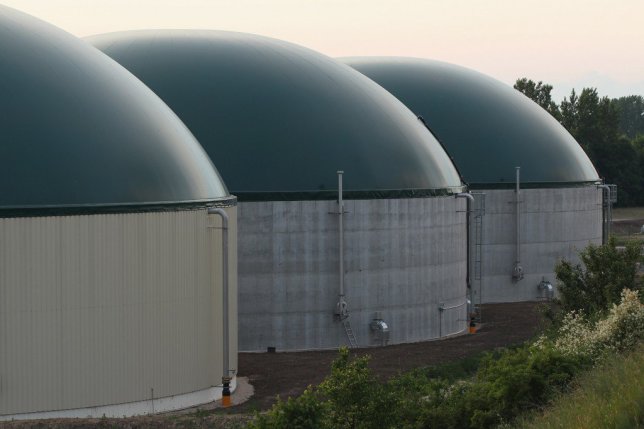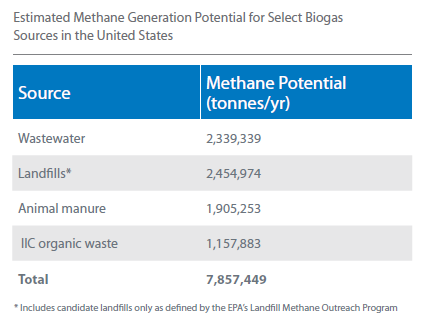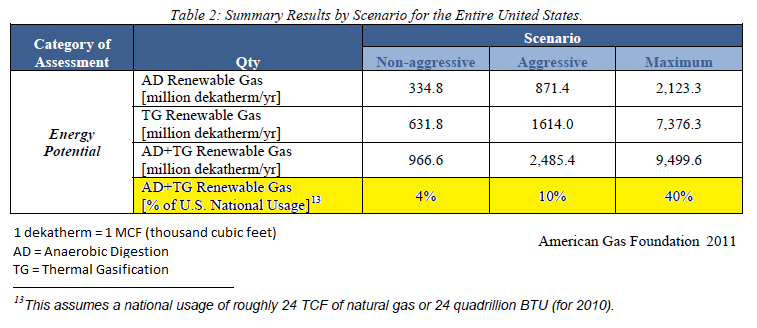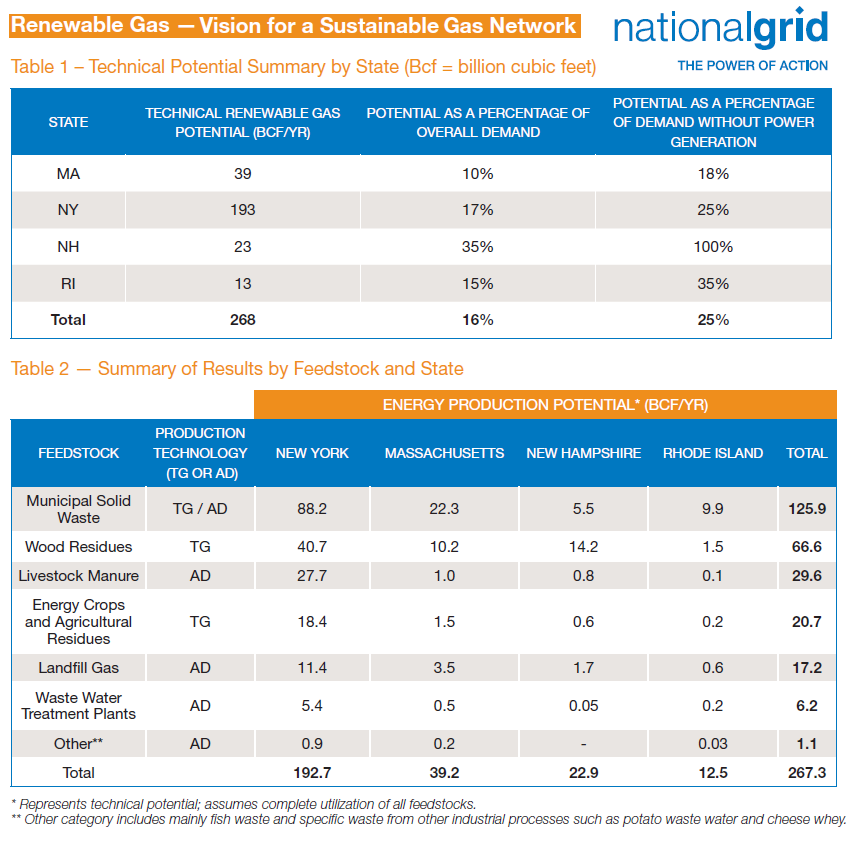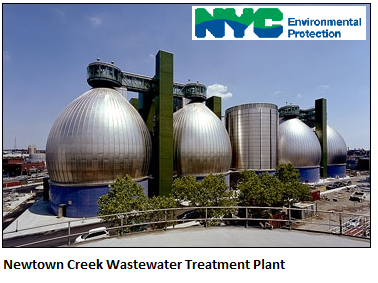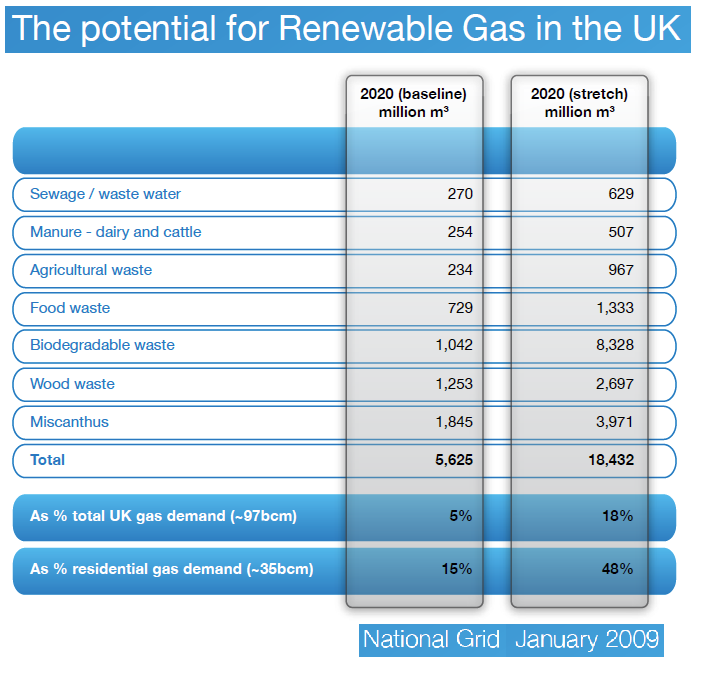Renewable natural gas (RNG) is methane produced from biomass that is cleaned to pipeline quality standards and blended with fossil natural gas. RNG, also known as biomethane, is carbon-neutral and chemically identical to fossil natural gas allowing it to be blended without restriction. Renewable natural gas is produced from a variety of (mostly waste) resources including landfills, sewage, farm waste and food waste. Biomass energy crops could be cultivated for RNG production, but currently those resources tend to be used for liquid fuels.
The major benefits of RNG production are that it takes methane that is already naturally produced from waste and going into the atmosphere as a potent greenhouse gas and turns it into a valuable carbon neutral fuel. RNG also helps address energy security because it is a locally produced fuel that is available in every community. RNG is also a universal fuel that is certified for use in existing infrastructure without technical issues and can be used for heat, power and transportation.
A series of studies from the government research agencies and industry in the last few years have found that anywhere from 5% to 20% of today’s natural gas demand could be met with RNG. These studies have attempted to quantify the resource by sector and region that are available for RNG production. The studies covered in this article do not include power to gas, nor synthetic natural gas which is produced from other fossil fuels such as coal.
Assumptions for how resources are calculated vary from model to model, particularly in the use of energy crops, which is the single biggest variable that differs among the studies. Conversion efficiencies and costs also vary by feedstock and by conversion process, but conversion efficiencies typically range from 60% – 70%.
USA, NREL (National Renewable Energy Laboratory)
Biogas Potential in the United States (Fact Sheet), 2013
The methane potential from landfill material, animal manure, wastewater, and industrial, institutional, and commercial organic waste in the United States is estimated at … about 420 billion cubic feet… This amount could displace about 5% of current natural gas consumption in the electric power sector and 56% of natural gas consumption in the transportation sector (EIA 2013).
The methane generation potential is expected to be much higher if lignocellulosic biomass resources are used. Future estimates reach 4.2 trillion cubic feet per year… which could displace about 46% of current natural gas consumption in the electric power sector and the entire natural gas consumption in the transportation sector.
AGA (American Gas Association)
The AGA is one of the USA’s major natural gas industry trade associations. AGA formally endorses the development of the RNG industry and the blending of biomethane with fossil natural gas in pipelines and for transportation.
AGA argues that RNG helps reduce greenhouse gas emissions, increases domestic energy production, improves waste management, provides new revenues for farmers, and helps creates jobs.
AGF (American Gas Foundation)
The American Gas Foundation is a group related to the AGA that conducted a major study in 2011 on US RNG resources and potential.
This report breaks down the resources by state and includes both anaerobic digestion and thermal gasification pathways.
This analysis presents three potential degrees or scenarios of total biomass utilization or market penetration:
- Non-aggressive. This scenario assumes roughly 5% -25% (depending on resource) of biomass is processed into biogas. Total RNG production is 0.97 quads per year or 4% of US natural gas demand.
- Aggressive. This scenario assumes 15%-75% (depending on resource) of biomass is processed into renewable gas. The Aggressive scenario represents a concerted national effort to employ this renewable resource. Total RNG production is 2.48 quads per year, 10% of US natural gas demand.
- Maximum. This scenario assumes 100% biomass utilization and conventional conversion efficiency. It provides a theoretical upper limit for renewable gas production. Total RNG production is 9.5 quads per year, or 40% of US natural gas demand.
Resources calculated for the study include:
- Animal waste from dairy cows, beef cattle, hogs and pigs, sheep, broiler chickens, turkeys and horses.
- Wastewater from 436 wastewater facilities.
- Landfill gas from 2,402 landfills.
- Municipal solid waste, thermal gasification of MSW not already used in waste to energy projects.
- Wood residue, from forests, mills and urban wood collection.
- Energy crops, switch grass, willow, hybrid poplar, but not food crops such as corn or soy.
- Agricultural residues, from corn, wheat, soybeans, cotton, sorghum, barley, oats, rice, rye canola, beans, peas, peanuts, potatoes, safflower, sunflower, and flaxseed.
National Grid is a major power and gas utility based in the UK but with significant operations in the Northeast USA. IN 2010 they released a study titled, Renewable Gas – Vision for a Sustainable Gas Network where they presented the business and resource caser for RNG in their operating area.
The biggest driver of renewable gas is GHG reduction, but what makes renewable gas more compelling is that it also enhances diversity of supply while providing a solution for using local waste resources to produce renewable energy.
National Grid estimates that over the long term renewable gas has the potential to meet up to 16% of the natural gas demand in the four states they service, Massachusetts, New Hampshire, Ney York and Rhode Island.
National Grid is a partner with the New York City Department of Environmental Protection on one of the biggest RNG projects in the USA. Newtown Creek is the largest of NYC’s 14 wastewater treatment plants and uses 8 digester eggs to process 1.5 million gallons of sewage sludge every day. Food waste is also added separately in a partnership with Waste Management, Inc. who preprocesses food waste collected from local schools into biosludge that is delivered to Newtown Creek for digestion. Methane production numbers were not available as the system is still undergoing commissioning.
National Grid commissioned a similar study in 2009 to analyze RNG potential in the UK. The report, titled The Potential for Renewable Gas in the UK, came to similar conclusions as reports in the USA. The baseline scenario found that 5% of UK natural gas demand could be met by RNG and that the aggressive or ‘stretch’ scenario was 18% of total UK gas demand.
NPC (National Petroleum Council)
The NPC issued a paper in March 2012, Renewable Natural Gas for Transportation. In the paper NPC finds:
- Approximately 4.7 trillion cubic feet of RNG is potentially available from domestic resources in the USA. 4.7 TCF is about 20% of US natural gas consumption.
- If used for transportation fuel, this amount of RNG would amount to 40 billion gasoline gallon equivalents per year and would result in 90% reductions in greenhouse gas emissions.
A literature review in the paper reviewing costs for RNG production states:
- The California Energy Commission estimated the costs of producing pipeline quality RNG from landfill gas to be $1.7 – $2.2/MMBTU.
- CALSTART estimated current (2010) RNG production costs of $5.9/MMBTU from livestock manure for a medium sized facility and $9/MMBTU for a smaller one. The dominant cost was upgrading the biogas to RNG: $4/MMBTU for a medium sized facility and $7/MMBTU for a small one. Biogas production was typically $2 per 1000 ft3 of biogas, with covered lagoons being the lowest cost and the large, covered lagoon system at Hilarides only $0.38.
- A 2009 California Energy Commission study did a detailed economic analysis of RNG from dairies injected into the pipeline using current technology and costs. They found that the cost of pipeline injection could be significant, especially for dairies miles from an interconnection to the natural gas grid. For example, the cost of pipeline injected RNG would be $12/MMBTU for the Hilarides Dairy compared to $42/MMBTU for the Castelanelli Dairy which would require 5 miles of Capital costs, including the costs to pipeline interconnect, were the cost drivers.
- NREL’s case study for biogas from dairy farms resulted in a RNG cost of $11/MMBTU delivered into the This consisted of $6 paid to the farmers, $2.5 for RNG production and $3 for delivery (10 miles) into the pipeline.
- ECN in the Netherlands estimated costs of RNG production from biomass using the MILENA gasification technology ranging from $13/MMBTU at a large facility to $42/MMBTU at a smaller one, including biomass costs of $3.7 to $7.7/MMBTU of RNG.
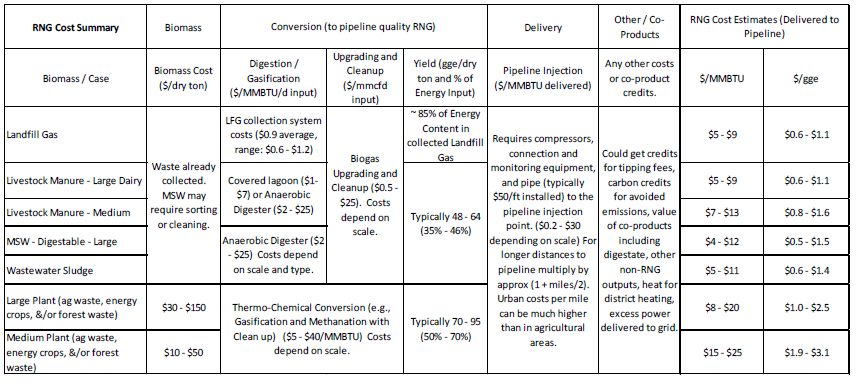 Bioenergy Association of California
Bioenergy Association of California
The Bioenergy Association of California issued a paper in November, 2014 calling for a Renewable Gas Standard, similar to the Renewable Portfolio Standard and the Renewable Fuels Standard to help promote RNG. According to BAC, RNG could meet over 10% of California’s roughly 2300 BCF annual natural gas demand.
World Bioenergy Association
The World Bioenergy Association from Stockholm, Sweden issued a fact sheet titled Biogas – An Important Energy Source, in which they state that 25% of global natural gas demand or 6% of global primary energy use could be met with biogas.
Conclusions
Though estimates vary for how much renewable natural gas can be produced, depending on how aggressively analysts calculate the resource base, and whether energy crops are included, there is a broad consensus that RNG can make a substantive and valuable contribution to global renewable energy production.
RNG offers multiple benefits. First, methane emissions from natural sources that would otherwise be going into the atmosphere as a potent greenhouse gas are converted into a valuable asset.
Second, RNG is a universal fuel that can be used for heat, power and transportation, meaning that it can be directed into sectors in greatest need of greenhouse gas reduction.
Third, since RNG is chemically identical to conventional natural gas, it can utilize existing infrastructure without concern for pipeline degradation or interference with end use devices. Alternative biofuels such as ethanol, methanol or biodiesel are greatly challenged in this regard because they are chemically different from the fossil fuels they seek to replace and require expensive upgrades to engines, storage and delivery systems.
Waste feedstocks for RNG production are widely distributed throughout society and every community has an opportunity to contribute to this valuable stream of renewable energy production. Anywhere there is waste, local citizens can be employed to convert this waste into valuable clean fuel creating win-win scenarios or an improved environment and improved energy security.
